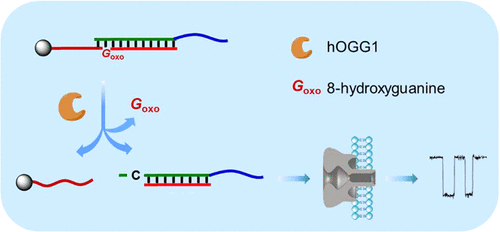Our official English website, www.x-mol.net, welcomes your
feedback! (Note: you will need to create a separate account there.)
Label-Free Sensing of Human 8-Oxoguanine DNA Glycosylase Activity with a Nanopore
ACS Sensors ( IF 8.2 ) Pub Date : 2018-02-02 00:00:00 , DOI: 10.1021/acssensors.7b00954 Jizhen Shang 1, 2 , Zhi Li 1 , Liping Liu 1 , Dongmei Xi 1 , Hua Wang 2
ACS Sensors ( IF 8.2 ) Pub Date : 2018-02-02 00:00:00 , DOI: 10.1021/acssensors.7b00954 Jizhen Shang 1, 2 , Zhi Li 1 , Liping Liu 1 , Dongmei Xi 1 , Hua Wang 2
Affiliation

|
Human 8-oxoguanine DNA glycosylase (hOGG1) plays a significant role in maintaining the genomic integrity of living organisms for its capability of repairing DNA lesions. Accurate detection of hOGG1 activity would greatly facilitate the screening and early diagnosis of diseases. In this work, we report a nanopore-based sensing strategy to probe the hOGG1 activity by employing the enzyme–catalytic cleavage reaction of DNA substrate. The hOGG1 specifically catalyzed the removal of the 8-hydroxyguanine (8-oxoG) and cleaved the DNA substrates immobilized on magnetic beads, thereby releasing the output DNA which would quantitatively produce the signature current events when subjected to α-hemolysin (α-HL) nanopore test. The approach enables the sensitive detection of hOGG1 activity without the need of any labeling or signal amplification route. Furthermore, the method can be applied to assay the inhibition of hOGG1 and evaluate the activity of endogenous hOGG1 in crude cell extracts. Importantly, since DNAs with specific sequences are the catalytic substrates of a wide variety of enzymes, the proposed strategy should be universally applicable for probing the activities of different types of enzymes with nanopore sensors.
中文翻译:

人类的8氧鸟嘌呤DNA糖基化酶活性与纳米孔的无标签传感。
人类8-氧鸟嘌呤DNA糖基化酶(hOGG1)在修复生物体的基因组完整性方面具有重要作用,因为它具有修复DNA损伤的能力。准确检测hOGG1活性将极大地促进疾病的筛查和早期诊断。在这项工作中,我们报告了一种基于纳米孔的传感策略,通过利用DNA底物的酶催化裂解反应来探测hOGG1的活性。hOGG1特异性催化8-羟基鸟嘌呤(8-oxoG)的去除并裂解固定在磁珠上的DNA底物,从而释放输出的DNA,当受到α-溶血素(α-HL)的作用时,该DNA将定量产生标志性的电流事件。纳米孔测试。该方法无需任何标记或信号放大途径即可灵敏地检测hOGG1活性。此外,该方法可用于分析hOGG1的抑制作用并评估粗细胞提取物中内源性hOGG1的活性。重要的是,由于具有特定序列的DNA是多种酶的催化底物,因此拟议的策略应普遍适用于用纳米孔传感器探测不同类型酶的活性。
更新日期:2018-02-02
中文翻译:

人类的8氧鸟嘌呤DNA糖基化酶活性与纳米孔的无标签传感。
人类8-氧鸟嘌呤DNA糖基化酶(hOGG1)在修复生物体的基因组完整性方面具有重要作用,因为它具有修复DNA损伤的能力。准确检测hOGG1活性将极大地促进疾病的筛查和早期诊断。在这项工作中,我们报告了一种基于纳米孔的传感策略,通过利用DNA底物的酶催化裂解反应来探测hOGG1的活性。hOGG1特异性催化8-羟基鸟嘌呤(8-oxoG)的去除并裂解固定在磁珠上的DNA底物,从而释放输出的DNA,当受到α-溶血素(α-HL)的作用时,该DNA将定量产生标志性的电流事件。纳米孔测试。该方法无需任何标记或信号放大途径即可灵敏地检测hOGG1活性。此外,该方法可用于分析hOGG1的抑制作用并评估粗细胞提取物中内源性hOGG1的活性。重要的是,由于具有特定序列的DNA是多种酶的催化底物,因此拟议的策略应普遍适用于用纳米孔传感器探测不同类型酶的活性。


















































 京公网安备 11010802027423号
京公网安备 11010802027423号